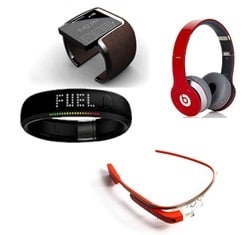There is plenty of discussion these days about ‘wearable
technology’, and many consumer electronics companies have ventured into
the market with a range of offerings. Everything from ‘smart
watches’ and augmented reality glasses, to t-shirts printed with
graphics that respond to sound. Many of these are still in their infancy or
are destined to be short-lived gadgets, and so far none of these products can
be said to have made a significant impact on consumers.
 However, in the health sector, wearable technology has both found a ready
market and is already making a significant impact. While applied mostly for
treatment today, wearable technology can have far bigger impact if applied
earlier in the health care cycle: increasing individual’s health
consciousness, coaching them to live healthier and screening for early signs
of diseases.
However, in the health sector, wearable technology has both found a ready
market and is already making a significant impact. While applied mostly for
treatment today, wearable technology can have far bigger impact if applied
earlier in the health care cycle: increasing individual’s health
consciousness, coaching them to live healthier and screening for early signs
of diseases.
Wearables will empower the worried-well to take ownership of their health, and
facilitate assisted living for the elderly or disabled. Wearables can help
prevent, diagnose early and more effectively treat diseases and lower
healthcare system costs.
Beneficial to both individuals and society, health-related applications will
become the key driver for the success of wearables. Not surprisingly,
recent announcements of wearable market shapers demonstrate their increased
health focus.
The first true wearable
It could be said that the original and most widely used type of wearable
device is the hearing instrument. Well over 12 million devices are supplied
every year, making it the de facto largest and a long-lived wearable market.
Electrical technology for these has a history as long as the telephone
– replacing the traditional (and questionably effective!) hearing
trumpets when people started adapting telephone receivers to help improve
their hearing. Wearability of hearing instruments evolved when moving to
vacuum tube and later discrete transistor amplification. When Jack
Kilby invented the integrated circuit in 1958, one of its first
commercial applications was the BTE (behind-the-ear) hearing aid.
Since then advances in hearing aids are driven by end user experience. Ease of
use has been improved with developments such as wireless connectivity and
battery life time extension. Performance was boosted by means of more advanced
signal processing, while miniaturization made devices ever-lighter and
smaller.
Decades of wearable experience at NXP

NXP has been actively developing the technology to make wearable medical
devices possible and practical, and is currently applying its experience to
several new applications. It has worked with OEMs for nearly
two decades, on devices powering hearing aids as well as hearing implants.
To meet the hearing industry’s demanding requirements NXP has developed
and deployed cutting edge high performance mixed signal solutions.

Highly integrated and optimized for ultra-low power operation, these devices
are tiny and run from a tiny 1V zinc air battery.
They encompass highly sensitive analog front-ends, low gate count powerful
Digital Signal Processors, non-volatile memory and wireless connectivity
streaming data and audio robustly around and safely through the body.
What’s next for wearables?
Future wearables will provide insight in your well-being, advise how to get
better, give early warning to seek professional support and inform caregivers
and nurses of patients in need of help.

Body-worn sensors will produce the raw data. They will be highly sensitive,
very small, battery operated and can be placed anywhere on your body. They
will be embedded in a wireless body area network which connects to the cloud
via watch or smartphone much in the way today’s comparatively simple
fitness trackers do. Smart algorithms will turn sensor data into actionable
information, which will be tailored to the intended recipient.
Hearing instruments do all of this, today. Having powered several generations
of them, NXP is well-positioned and ready to address the unique needs of the
wearable market.


 However, in the health sector, wearable technology has both found a ready
market and is already making a significant impact. While applied mostly for
treatment today, wearable technology can have far bigger impact if applied
earlier in the health care cycle: increasing individual’s health
consciousness, coaching them to live healthier and screening for early signs
of diseases.
However, in the health sector, wearable technology has both found a ready
market and is already making a significant impact. While applied mostly for
treatment today, wearable technology can have far bigger impact if applied
earlier in the health care cycle: increasing individual’s health
consciousness, coaching them to live healthier and screening for early signs
of diseases.




